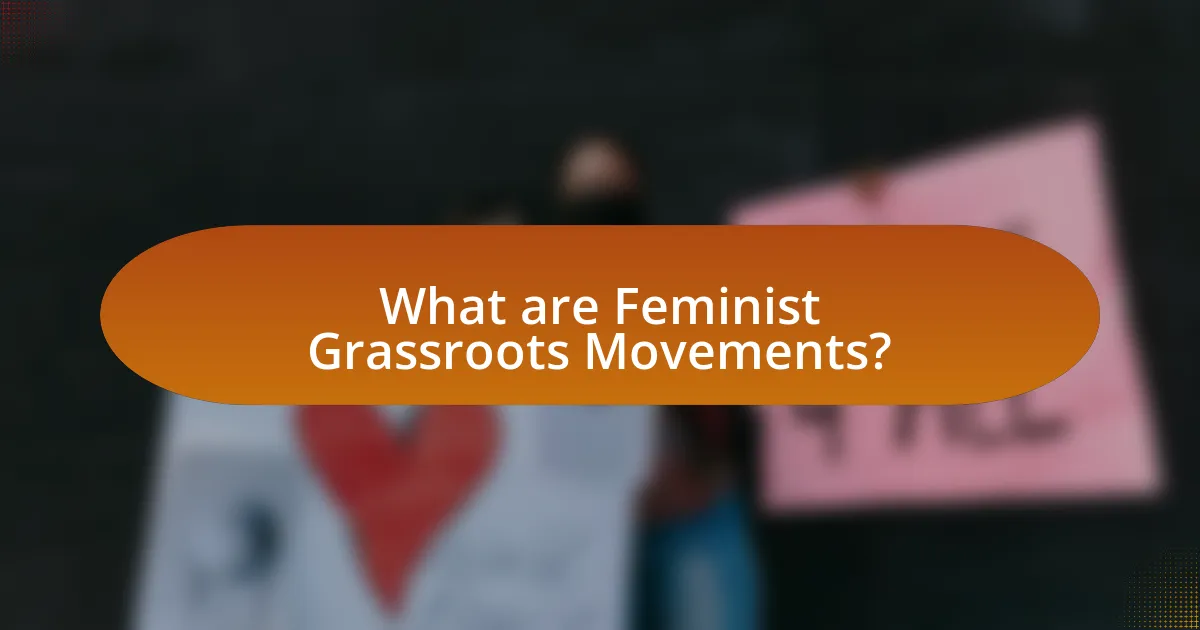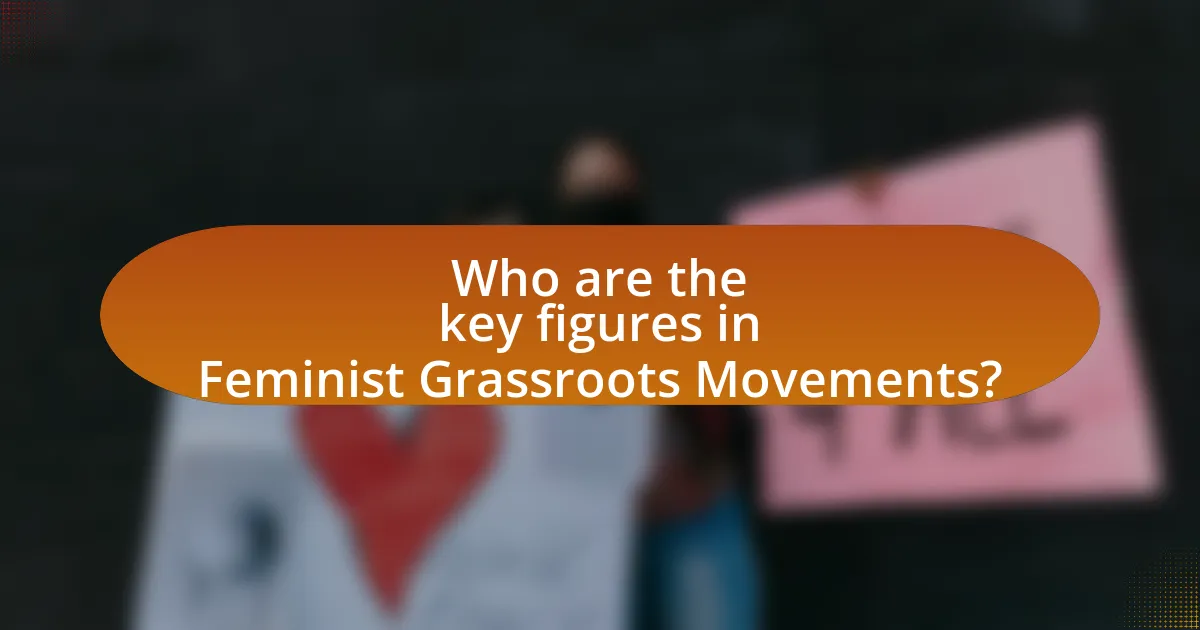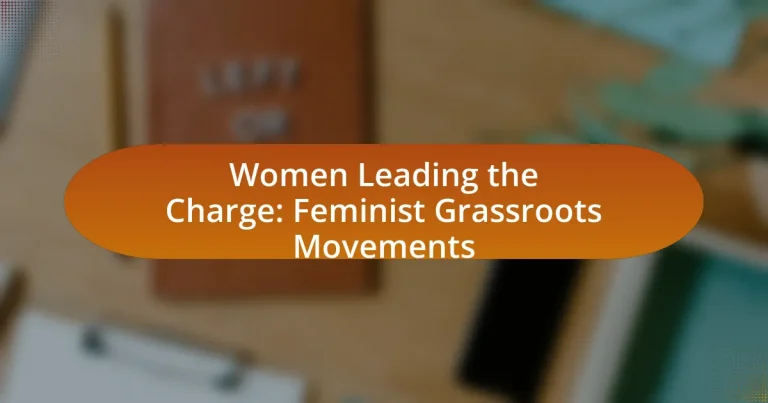Feminist grassroots movements are community-driven initiatives that advocate for women’s rights and gender equality, focusing on issues such as reproductive rights, domestic violence, and workplace equality. These movements differ from traditional feminist organizations by emphasizing local activism and inclusivity, allowing for immediate responses to community needs. Key historical events, influential figures, and the role of intersectionality shape these movements, which utilize strategies like social media for mobilization and advocacy. Despite facing challenges such as funding limitations and societal resistance, feminist grassroots movements significantly impact policy and societal attitudes towards gender equality, empowering individuals to engage in activism and support local initiatives.

What are Feminist Grassroots Movements?
Feminist grassroots movements are community-based initiatives that advocate for women’s rights and gender equality through local organizing and activism. These movements often emerge from the needs and experiences of women in specific communities, focusing on issues such as reproductive rights, domestic violence, workplace equality, and intersectionality. For instance, the Women’s March, which began in 2017, mobilized millions globally to address various feminist issues, demonstrating the power of grassroots organizing. Such movements are characterized by their emphasis on collective action, inclusivity, and the empowerment of marginalized voices within the feminist discourse.
How do Feminist Grassroots Movements differ from traditional feminist organizations?
Feminist grassroots movements differ from traditional feminist organizations primarily in their structure and approach to activism. Grassroots movements emphasize local, community-driven initiatives and often operate without formal hierarchies, allowing for more inclusive participation and immediate responsiveness to local issues. In contrast, traditional feminist organizations typically have established leadership structures and may focus on broader policy advocacy or institutional change, which can sometimes lead to slower responses to urgent community needs. For example, grassroots movements like the Women’s March have mobilized quickly in response to specific events, demonstrating their agility and community focus, while traditional organizations may take longer to formulate responses due to their bureaucratic processes.
What are the key characteristics of Feminist Grassroots Movements?
Feminist grassroots movements are characterized by their emphasis on local activism, inclusivity, and community engagement. These movements prioritize the voices and experiences of marginalized women, often focusing on issues such as reproductive rights, gender-based violence, and economic inequality. For instance, the Women’s March, which began in 2017, exemplifies how grassroots organizing can mobilize diverse groups to advocate for women’s rights on a global scale. Additionally, these movements often utilize social media platforms to amplify their messages and connect with a wider audience, demonstrating the power of digital activism in contemporary feminist efforts.
Why are grassroots movements essential for feminist activism?
Grassroots movements are essential for feminist activism because they empower individuals at the community level to advocate for gender equality and social justice. These movements facilitate direct participation, allowing marginalized voices to be heard and fostering a sense of ownership over the issues that affect them. Historical examples, such as the Women’s March in 2017, demonstrate how grassroots organizing can mobilize large numbers of people to demand change, influencing public policy and raising awareness about women’s rights. Additionally, grassroots movements often create networks of support and solidarity, which are crucial for sustaining long-term activism and achieving tangible results in the fight for gender equality.
What historical context has shaped Feminist Grassroots Movements?
Feminist grassroots movements have been shaped by historical contexts such as the suffrage movement, civil rights struggles, and the second-wave feminism of the 1960s and 1970s. The suffrage movement, which gained momentum in the late 19th and early 20th centuries, established foundational principles of women’s rights and mobilized women to advocate for political representation. The civil rights movement further influenced feminist activism by highlighting intersectionality and the need to address issues of race alongside gender. Additionally, the second-wave feminism introduced concepts of reproductive rights, workplace equality, and sexual liberation, which galvanized grassroots organizing and community-based activism. These historical contexts provided the framework and urgency for contemporary feminist grassroots movements, emphasizing collective action and local engagement to address systemic inequalities.
How have past feminist movements influenced current grassroots initiatives?
Past feminist movements have significantly shaped current grassroots initiatives by establishing foundational frameworks for advocacy, community organizing, and intersectionality. The suffragette movement, for example, not only secured voting rights for women but also inspired subsequent generations to mobilize for broader social justice issues, emphasizing the importance of collective action. Additionally, the second-wave feminist movement of the 1960s and 1970s introduced concepts such as reproductive rights and workplace equality, which continue to be central themes in contemporary grassroots campaigns. Research indicates that organizations like the Women’s March, which emerged in 2017, draw directly from these historical movements, utilizing strategies of protest and coalition-building that were pioneered by earlier feminists. This continuity illustrates how past feminist efforts provide both a blueprint and a source of inspiration for today’s activists, fostering a culture of resilience and advocacy in grassroots initiatives.
What significant events have marked the evolution of these movements?
Significant events that have marked the evolution of feminist grassroots movements include the Seneca Falls Convention in 1848, which was the first women’s rights convention in the United States, and the establishment of the National Organization for Women (NOW) in 1966, which aimed to advocate for women’s equality. The Women’s Liberation Movement of the 1960s and 1970s further propelled these movements, leading to landmark legislation such as Title IX in 1972, which prohibited gender discrimination in education. Additionally, the #MeToo movement, which gained prominence in 2017, highlighted sexual harassment and assault, galvanizing global awareness and activism around women’s rights. These events collectively illustrate the ongoing struggle and progress within feminist grassroots movements.

Who are the key figures in Feminist Grassroots Movements?
Key figures in feminist grassroots movements include Angela Davis, bell hooks, and Audre Lorde. Angela Davis is known for her activism in the civil rights and feminist movements, particularly her work on prison abolition and intersectionality. bell hooks has contributed significantly to feminist theory, emphasizing the importance of race, class, and gender in her writings. Audre Lorde, a self-identified Black lesbian feminist, focused on the intersection of race, gender, and sexuality, advocating for social justice and empowerment. These individuals have played pivotal roles in shaping feminist discourse and mobilizing grassroots activism.
What roles do women leaders play in these movements?
Women leaders play crucial roles in feminist grassroots movements by driving advocacy, mobilizing communities, and shaping policy agendas. They often serve as spokespersons, articulating the needs and rights of marginalized groups, which enhances visibility and awareness of social issues. For instance, leaders like Malala Yousafzai have galvanized global attention on girls’ education, demonstrating how female leadership can influence international discourse. Additionally, women leaders frequently organize grassroots campaigns, leveraging their networks to foster solidarity and collective action, as seen in the Women’s March, which united millions worldwide in 2017. Their leadership not only empowers other women but also challenges systemic inequalities, making their contributions vital to the success and sustainability of these movements.
How do these leaders inspire and mobilize communities?
These leaders inspire and mobilize communities by fostering a sense of shared purpose and empowerment among individuals. They utilize effective communication strategies, such as storytelling and public speaking, to articulate their vision and connect emotionally with community members. For instance, grassroots leaders often organize workshops and community meetings that encourage participation and dialogue, creating an inclusive environment where voices are heard. Research shows that movements led by women, such as the Women’s March, have successfully mobilized millions by emphasizing collective action and solidarity, demonstrating the power of grassroots organizing in driving social change.
What challenges do women leaders face in grassroots activism?
Women leaders in grassroots activism face significant challenges, including gender bias, limited access to resources, and societal expectations. Gender bias manifests in the form of skepticism regarding their leadership capabilities, often leading to underrepresentation in decision-making roles. Limited access to resources, such as funding and networks, hampers their ability to mobilize effectively and sustain initiatives. Societal expectations often impose traditional roles on women, which can conflict with their activism efforts, creating additional barriers to their leadership. These challenges are supported by research indicating that women in leadership positions frequently encounter obstacles that their male counterparts do not, affecting their overall impact in grassroots movements.
How do intersectionality and diversity impact Feminist Grassroots Movements?
Intersectionality and diversity significantly enhance Feminist Grassroots Movements by ensuring that the experiences and needs of various marginalized groups are represented and addressed. This inclusivity allows movements to challenge systemic inequalities more effectively, as they recognize that issues such as race, class, sexuality, and ability intersect and compound the oppression faced by individuals. For instance, the Combahee River Collective, formed in the 1970s, emphasized the importance of addressing the unique struggles of Black women, illustrating how intersectional perspectives can lead to more comprehensive advocacy and policy changes. By incorporating diverse voices, these movements can mobilize broader support and create solutions that resonate with a wider audience, ultimately strengthening their impact and effectiveness.
What is the importance of inclusivity within these movements?
Inclusivity is crucial within feminist grassroots movements as it ensures diverse voices and experiences are represented, leading to more comprehensive and effective advocacy. When movements embrace inclusivity, they can address the unique challenges faced by various groups, such as women of color, LGBTQ+ individuals, and those from different socioeconomic backgrounds. Research indicates that inclusive movements are more successful in mobilizing support and achieving policy changes, as they resonate with a broader audience and foster solidarity among different communities. For instance, the Women’s March in 2017 highlighted the importance of intersectionality, bringing together diverse groups to advocate for women’s rights on a global scale, demonstrating that inclusivity enhances the movement’s impact and reach.
How do different identities shape the goals and strategies of grassroots activism?
Different identities significantly shape the goals and strategies of grassroots activism by influencing the perspectives, priorities, and methods employed by activists. For instance, women of color in feminist movements often prioritize intersectionality, addressing issues such as racial injustice alongside gender equality, which leads to strategies that incorporate community engagement and coalition-building. Research by Crenshaw (1989) highlights how the intersection of race and gender creates unique challenges that inform activism, demonstrating that diverse identities lead to more comprehensive and inclusive approaches. Additionally, LGBTQ+ activists may focus on issues like marriage equality and anti-discrimination laws, shaping their strategies around visibility and representation. This diversity in identity not only broadens the scope of activism but also enhances its effectiveness by ensuring that multiple voices and experiences are represented in the movement.

What strategies do Feminist Grassroots Movements employ?
Feminist grassroots movements employ strategies such as community organizing, advocacy, and coalition-building to promote gender equality and social justice. Community organizing involves mobilizing individuals at the local level to address specific issues, such as reproductive rights or domestic violence, fostering a sense of collective identity and empowerment. Advocacy efforts focus on influencing policy changes through lobbying, public campaigns, and raising awareness about women’s rights issues. Coalition-building brings together diverse groups, including marginalized communities, to strengthen their collective voice and impact. These strategies have been effective in achieving tangible outcomes, such as the passage of legislation aimed at protecting women’s rights and increasing representation in decision-making processes.
How do these movements utilize social media for activism?
Feminist grassroots movements utilize social media for activism by creating platforms for awareness, mobilization, and community building. These movements leverage social media to disseminate information rapidly, engage supporters, and organize events, exemplified by campaigns like #MeToo, which gained global traction through Twitter and Instagram, allowing survivors to share their stories and connect with others. Research indicates that social media has significantly increased participation in feminist activism, with a study by the Pew Research Center showing that 70% of activists believe social media is essential for their efforts.
What are the advantages of digital platforms for grassroots organizing?
Digital platforms provide significant advantages for grassroots organizing by enhancing communication, mobilization, and resource sharing. These platforms enable activists to reach a wider audience quickly, facilitating the rapid dissemination of information and calls to action. For instance, social media channels like Twitter and Facebook have been pivotal in organizing events such as the Women’s March, which drew millions globally in 2017, showcasing the power of digital outreach. Additionally, digital tools allow for real-time collaboration and coordination among grassroots groups, making it easier to strategize and respond to emerging issues. Research indicates that organizations utilizing digital platforms can increase engagement and participation rates, as seen in studies by the Pew Research Center, which highlight the effectiveness of online campaigns in driving social movements.
How do online campaigns translate into offline action?
Online campaigns translate into offline action by mobilizing supporters through digital platforms, which facilitate awareness and engagement around feminist issues. For instance, social media campaigns often lead to organized protests, community events, or advocacy initiatives, as seen in movements like #MeToo, where online discussions prompted widespread offline demonstrations and policy changes. Research indicates that 70% of participants in offline feminist actions reported being influenced by online campaigns, highlighting the effectiveness of digital outreach in driving real-world activism.
What are the common challenges faced by Feminist Grassroots Movements?
Feminist grassroots movements commonly face challenges such as limited funding, lack of visibility, and internal divisions. Limited funding restricts their ability to sustain operations and expand outreach, as many rely on small donations or grants that may not cover all expenses. Lack of visibility often results in insufficient public awareness and support, making it difficult to mobilize larger audiences or influence policy effectively. Internal divisions can arise from differing ideologies or priorities among members, which can hinder collective action and weaken the movement’s overall impact. These challenges are documented in various studies, including the “State of Women’s Movements” report by the Association for Women’s Rights in Development, which highlights the financial and organizational struggles faced by grassroots initiatives.
How do funding and resource limitations affect their effectiveness?
Funding and resource limitations significantly hinder the effectiveness of feminist grassroots movements. These constraints restrict their ability to mobilize, organize, and implement initiatives that address gender inequality. For instance, a study by the Association for Women’s Rights in Development (AWID) found that 70% of women’s rights organizations reported funding shortages, which directly impacted their capacity to deliver programs and advocate for policy changes. Limited financial resources also lead to reduced staffing, limiting the expertise and outreach necessary for impactful activism. Consequently, these movements struggle to sustain momentum and achieve long-term goals, ultimately diminishing their overall effectiveness in promoting gender equality.
What strategies do movements use to overcome these challenges?
Feminist grassroots movements employ various strategies to overcome challenges such as funding limitations, societal resistance, and internal divisions. These strategies include building coalitions with other social justice organizations to amplify their voices and resources, utilizing social media for awareness and mobilization, and engaging in grassroots fundraising to ensure financial sustainability. For instance, the Women’s March, which began in 2017, successfully mobilized millions globally by leveraging social media platforms to organize and promote events, demonstrating the effectiveness of digital outreach in overcoming traditional barriers to participation. Additionally, movements often focus on education and awareness campaigns to shift public perception and garner broader support, as seen in initiatives like the #MeToo movement, which raised awareness about sexual harassment and assault, leading to significant cultural and legislative changes.
What impact do Feminist Grassroots Movements have on society?
Feminist grassroots movements significantly impact society by promoting gender equality and social justice. These movements mobilize communities to advocate for women’s rights, challenge systemic oppression, and influence policy changes. For instance, the #MeToo movement, which began as a grassroots initiative, led to widespread awareness of sexual harassment and assault, resulting in legislative changes in various countries aimed at protecting victims and holding perpetrators accountable. Additionally, grassroots organizations often provide essential support services, such as legal aid and educational resources, empowering women and fostering community resilience. The effectiveness of these movements is evidenced by their ability to create dialogue, shift cultural norms, and inspire collective action, ultimately contributing to a more equitable society.
How do these movements influence policy and legislation?
Feminist grassroots movements influence policy and legislation by mobilizing public support, raising awareness, and advocating for specific legal changes. These movements often utilize campaigns, protests, and social media to highlight issues such as gender equality, reproductive rights, and workplace discrimination, effectively shaping public discourse. For instance, the #MeToo movement significantly impacted legislation related to sexual harassment and assault, leading to the introduction of new laws in various jurisdictions aimed at protecting victims and holding perpetrators accountable. Additionally, studies have shown that grassroots activism can lead to increased representation of women in political offices, further facilitating the enactment of policies that address women’s rights and issues.
What role do they play in changing societal attitudes towards gender equality?
Feminist grassroots movements play a crucial role in changing societal attitudes towards gender equality by mobilizing communities, raising awareness, and advocating for policy changes. These movements engage individuals at the local level, fostering discussions that challenge traditional gender norms and promote equal rights. For instance, the #MeToo movement, which began as a grassroots initiative, significantly shifted public perception regarding sexual harassment and assault, leading to increased accountability for perpetrators and greater support for survivors. Research indicates that grassroots activism can lead to measurable changes in public attitudes; a study published in the Journal of Social Issues found that community-based campaigns effectively increased awareness and support for gender equality initiatives.
What can individuals do to support Feminist Grassroots Movements?
Individuals can support feminist grassroots movements by actively participating in local initiatives and advocating for gender equality. Engaging in community organizing, volunteering time and skills, and attending events or workshops can amplify the voices of these movements. Financial contributions to organizations that focus on women’s rights and social justice also provide essential resources for their efforts. Research indicates that grassroots movements are more effective when they have community backing; for instance, the Women’s March in 2017 mobilized millions globally, demonstrating the power of collective action. By sharing information on social media and educating others about feminist issues, individuals can further raise awareness and foster a supportive environment for these movements.
How can community members get involved in local initiatives?
Community members can get involved in local initiatives by participating in volunteer opportunities, attending community meetings, and joining local organizations focused on specific causes. Engaging in these activities allows individuals to contribute their skills and time to support initiatives that align with their values. For instance, research shows that grassroots movements, particularly those led by women, often rely on community participation to drive change and mobilize resources effectively. According to a study published in the Journal of Community Engagement and Scholarship, active involvement in local initiatives fosters a sense of belonging and empowerment among participants, which is crucial for the success of feminist grassroots movements.
What are effective ways to advocate for feminist causes in everyday life?
Effective ways to advocate for feminist causes in everyday life include engaging in conversations about gender equality, supporting women-owned businesses, and participating in local feminist organizations. Engaging in conversations raises awareness and educates others about feminist issues, which is crucial for societal change. Supporting women-owned businesses not only empowers female entrepreneurs but also contributes to economic equality. Participating in local feminist organizations provides a platform for collective action and amplifies the voices of marginalized women. According to a 2020 report by the World Economic Forum, gender parity could take over 135 years to achieve, highlighting the urgency of grassroots advocacy.

